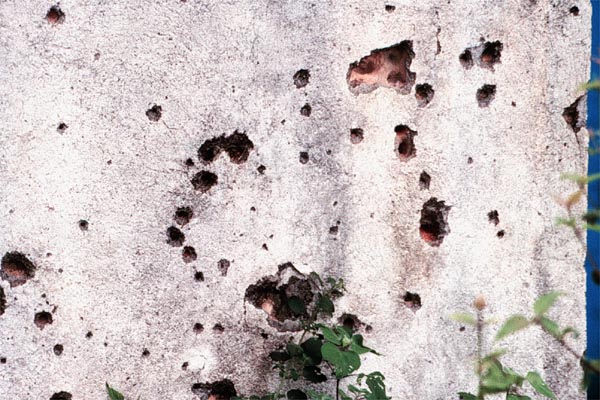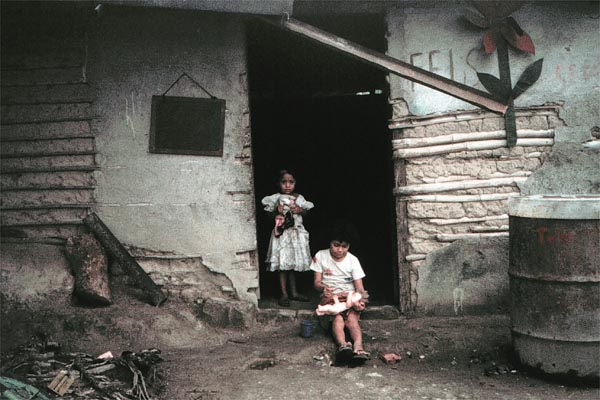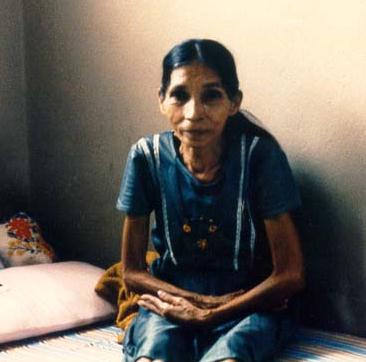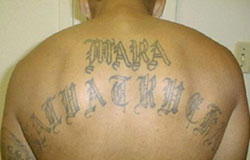War in El Salvador
In order to truly understand the complexity of international gang transfer, it is necessary to note El Salvador’s history and the struggles of its people.

A reminder of violence; these are bullet holes in the wall of the community center of Mozote.
El Salvador: History to the Civil War
As is the case in many other Latin American countries, early El Salvador was once inhabited by a people who hunted and gathered to survive. However, the geographic location of several active volcanoes helped to wipe out most of these early civilizations. Later, the Mayans and Aztecs would have a serious impact on the culture. By the time the conquistadors settled in El Salvador, a group they called the Pipiles had taken control. The Pipiles fiercely resisted the Spanish influence, and it took many years to seize the entire area under control. They were forced into labor on encomiendas or large portions of land owned by wealthy Spanish families. This resistance would be used as inspiration for later generations during the civil war. More than half of the indigenous population perished; today, over half of the population is mestizo, with a small percentage of both indigenous and Caucasians. El Salvador finally obtained independence from Spain in 1821, adding to the oppression of the peasants because the rich of El Salvador still controlled the land. Up until the Civil War, there had been several uprisings by different groups, such as the Nunualco in the 1830’s, and the coffee workers in the 1930's, who all wanted better living conditions.1

Many of the rural peasants lived in extreme poverty. These children are playing in a run-down school in La Libertad.
The Economy
Much like other South American countries, El Salvador’s main exports are agricultural: sugarcane, coffee, cotton, and fishing. However, most of these products are exported to other nations, such as the United States or Germany. As a result, El Salvador’s people cannot feed themselves; most of the farms are commercially run, leaving the peasants without an opportunity to feed themselves. Coffee is the money maker, but the only sustenance in coffee goes directly to the business owners of the “super-farms.” In the 1920’s, coffee prices dropped dramatically, plunging the people into an even more desperate poverty that was the catalyst for the Civil War. Living conditions took a turn for the worse. 2
The Civil War- 1970-1992
Church Influence
Extreme poverty leads to a restless people. Also, a changing Catholic Church contributed to the restlessness. Under Vatican II, more of the ministry was focused on changing the living conditions of the poor instead of serving the needs of those companies in power. Many ministries came to El Salvador and taught these new ideas; people can ask for a better life now on earth, rather than waiting for the “heavenly kingdom.” With these new ideas, the poor were more likely to resent their current living conditions and work for a change. The formation of many groups followed these policies. 3
“Being a Christian Base community is not simply about praying the Rosary and going to Mass. It is about action. As we reflect on the work of God, we are called to act as a body. Because if we do not build the Reign of God here on earth, there will be nothing for us in the herafter” -Testimony from Project Salvador Update 4
Major Groups of the Civil War
ESAF- El Salvadorean Armed Forces- These were mostly untrained militants fighting for the El Salvadorean government during the war. They used military tactics on unarmed citizens in a policy of oppression.
FMLN- Farabundo Marti Front for National Liberation- This was one of the peasant groups that fought the government using guerilla warfare tactics. They usually hid amongst regular villages as cover, or in the mountains.
Sombra Negra- A still-operating group of vigilantes that want to purge El Salvador of criminal activity, including those in youth gangs. 5
Death Squads-Groups of U.S. trained, Salvadorean troops that used severe torture technics, including electric shock, rape, mutilation, and burning. 6

This woman was tortured for two years and died shortly after this picture was taken. She was accused of supporting the FMLN, but in reality she had refused to become the mistress of an army officer.
The Killings: The Pain of the People
1931- La Mazata- Led by members of the communist party in El Salvador and coffee workers outraged by the wage cuts, this revolt tried to change the living conditions of people working in agriculture. About 30,000 indigenous people were massacred over the course of several days, and the military seized control of the civilian government.
1980- Archbishop Oscar Arnulfo Romero, a clergyman fighting for the rights of the poor, was assassinated while at mass.
1981-El Mozote- A military group in the Atlacatl Batallion, a part of the ESAF, surrounded the town of Mozote, and accused the people of aiding guerilla militants in the area. Everyone in the village was told to remain indoors or risk execution. The next day, the people were brought into the town square and separated. The women were raped then murdered, while the men and children were lined up and shot. Over 900 civilians died; the U.S. government denied the entire incident, claiming that it was communist propaganda generated by guerillas.
1989- A Death Squad murdered six Jesuit priests, their housekeeper, and her daughter. Church leaders are outraged, pressuring the U.S. government to take action. 7
“The death squad members must all be guilty of every murder; so one rapes, another strikes blows, another uses the machete, and so on until it would be impossible to determine which action had caused the death, and the squad members are protected from each other by mutual guilt. Also, when mere death no longer instills fear in the population, the stakes must be raised. The people must be made to see that not only will they die, but die slowly and brutally.”-8
The Effects of War
After analyzing the violence of Salvadorian society during the Civil War, it is easy to understand why over 1 million of the citizens fled to other countries. 9 Entire families were torn; many members had fled, while some had members fighting for both guerillas and the regular military. This severely fractured many of the basic principles of family life in El Salvador. Living in constant fear also psychologically traumatized those fleeing from both guerillas and the government. Many from the small villages had seen or had known of a family member brutalized by the war. Half of the 80,000 casualties of war were civilians, with 70,000 others mutilated by serious injury.10 Those who were able to escape to the United States brought with them a history of living in terror and poverty.
"No les dije?"
"Si sólo se oía aquella gran gritazón."
"Didn't I tell you?
All you could hear was that enormous screaming."
-Rufina Amaya, sole survivor of the Mozote massacre 11
